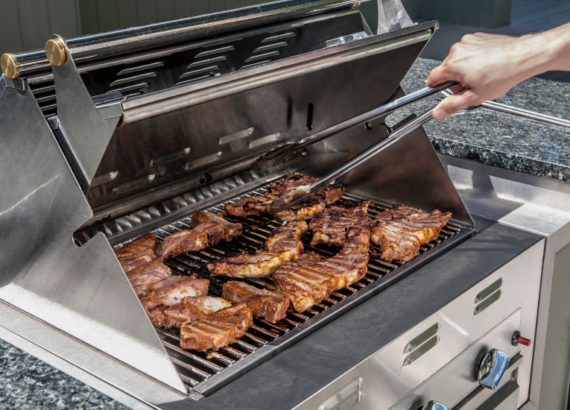How To Keep Your Patio Heater From Tipping Over

Did you recently buy a new patio heater for your outdoor patio? It’s important to keep your patio heater in great condition for years. One way to do that is to keep it upright. Luckily it’s not that complicated. Here’s a closer look at how to keep your patio heater from tipping over.
You can:
- Add weight to the base of the patio heater.
- Secure your patio heater to a post.
- Bolt your patio heater to the ground.
- Place your patio heater on a flat, hard surface in a low traffic area.
Table of Contents
Add weight to the base of the patio heater.
Most modern patio heaters have reservoirs on the bottom where you can add weight. Water or sand are great options to weigh down your patio heater. Sand is best because water evaporates over time. You’ll need to keep refilling the reservoir to keep your patio heater stable.
If your patio heater doesn’t have a reservoir, you can set sandbags or water weights on the base to weigh it down. Water weights are a little more reliable because they’re much cleaner to use. Sandbags can tear open and make a mess on your patio.
Here’s an example of a water weight from Amazon. It’s manufactured by AZ Patio Heaters. If you don’t have an AZ patio heater and want to use this weight, contact your manufacturer first. They may or may not have a better solution for you.
Secure it to a post on your patio.
Any stable stone or concrete post should do the job. Be cautious if you’re securing the patio heater to a wooden post. This could be a fire hazard so make sure the heater is as far away from the post as possible.
Concrete or stone is best because they are much more fire-resistant. If you don’t use your patio heater often or for long periods of time, wooden posts are OK. Don’t let the patio heater touch the wooden post.
To secure the patio heater, you can use bungee cords or heat-resistant zip ties. Quality zip ties are heat-resistant up to about 185º which should work for almost all residential patio heaters.
Bolt your patio heater to the ground.
If you know exactly where you want your patio heater, you can bolt it to the ground to keep it from tipping over. But if you want to heat multiple areas at different times, don’t bolt it to the ground.
You could consider buying a second heater that’s portable and bolting your current one to the ground, too. That’ll give you more flexibility if you want to heat multiple guest areas on your patio.
Be careful to not drill a hole in the reservoir or damage the patio heater’s internal components when bolting it to the ground.
Place your patio heater on a flat, hard surface in a low traffic area.
It’s important that your patio heater is stable. If it wobbles at all, a little wind can tip it over easily. Set your patio heater on concrete, brick, or stone rather than grass. It’s difficult to find a perfectly even area on grass unless you level it first. Not to mention that grass is combustible. So you run the risk of a fire if your patio heater is on for too long or tips over.
Where to Place Your Patio Heater to Prevent it from Tipping
The placement of your patio heater is key to making sure it stays upright.
The best place to put your patio heater is:
- On a flat surface
- In a semi-enclosed area or corner
- In a low traffic area
- Away from trees
- On concrete, tile, stone, or other hard surfaces
On a flat surface
Patio heaters get quite hot; if tipped over, you could get injured. Also, most patio heaters are tall so even the slightest incline can make them unstable. Patio heaters on a sloped surface are much more vulnerable to wind or harsh weather, too.
In a semi-enclosed area or corner
If you put your patio heater in a semi-enclosed area, it can have some protection from the wind and the elements. Corners are best to break the wind because you have walls on two sides.
In a low traffic area
Keep your patio heater away from high-traffic areas like pathways or dining rooms. You can place the heater in a high-traffic area but not where people are walking. It’s easy to knock the patio heater over, especially if you are hosting a barbecue with dozens of people.
Away from trees
Trees are not only a fire hazard but they can also fall on your patio heater. If your patio heater is not weighed down properly – or if the branch is heavy – it could tip over. To reduce the risk of fire, avoid placing your patio heater around shrubs and grass as well.
On concrete, tile, stone, or other hard surfaces
Stability is your best friend. Concrete, stone, and tile are some of the most stable surfaces for your patio heater. But you’ll want to avoid soft terrain like grass or uneven surfaces like gravel and pavers.
Look for a patio heater with an anti-tilt feature.
Modern patio heaters feature an anti-tilt switch or device. This triggers when your patio heater tips over and turns it off instantly. This is a great safety feature in case your heater does tip over. Hopefully you’re there to deal with the situation. But accidents do happen.
Maybe you left your patio heater out during harsh weather and it fell over. With the anti-tilt feature, you don’t have to worry about starting a fire on your patio.
How to Test Anti-Tilt Switch
Most patio heater manuals don’t have specific instructions on how to test the anti-tilt switch. So you’ll likely have to call the manufacturer and ask them how to ensure it works properly. Depending on the patio heater, you might be able to manually trigger the device.
Avoid tilting your patio heater while it’s running for your safety. You might end up damaging the heater or injuring yourself while trying to trigger the switch. You may be able to test the switch in this way with a friend. But be careful!
Cover your patio heater when you’re not using it.
Strong wind should be your main concern. While you’re asleep, out of the house, or inside, your patio heater can tip over during harsh weather. So, pack it in a cover when you’re not using it. Most manufacturers have a case for the specific size patio heater you bought. If not, just measure your patio heater and look for a cover that fits that size.
Check the weather forecast and store your patio heater during inclement weather.
It’s a good idea to keep a close eye on the weather forecast. Especially if you live in an area where weather can be unpredictable. Here in Utah, it can snow one day and be 80º the next.
If you’re out on your patio in the late winter or early spring season, it still might be cold and rainy. When rain is in the forecast, cover your patio heater and store it in a dry area like a shed.
That wraps up our post on how to keep your patio heater from tipping over. Be sure to fill the reservoir with sand or water to weigh your heater down. Also make sure the heater is on a flat, hard, and stable surface.
Thanks for reading! For more about patio heaters and all things patio, check out the articles below!
Related Articles
12 Patio Heater Safety Tips You Should Know







Comments are closed.